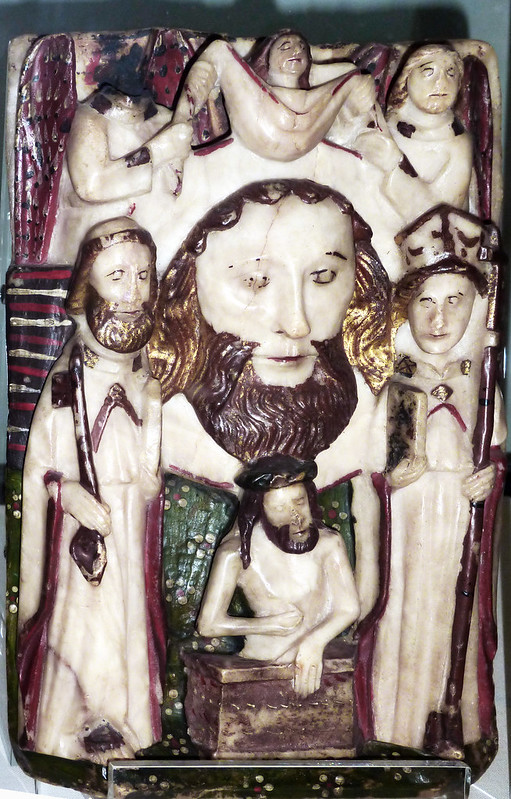Yesterday was St Scholastica's day, and I think I can report that there were no riots in Oxford this year, unlike 660 years ago, for which
vide St Scholastica Day riot.
That is unless that is one counts the meeting of Convocation today in the Sheldonian to discuss the height of the flats the University has built by the Castle Mill Stream that overlook Port Meadow. I suspect we have not heard the last of that particular question.
St Scholastica, the sister of St Benedict, is remembered particularly for the following episode shortly before her death:
Scholastica,
the sister of Saint Benedict, had been consecrated to God from her
earliest years. She was accustomed to visiting her brother once a year.
He would come down to meet her at a place on the monastery property, not
far outside the gate.
One day she came as usual and her saintly brother went
with some of his disciples; they spent the whole day praising God and
talking of sacred things. As night fell they had supper together.
Their spiritual conversation went on and the hour grew
late. The holy nun said to her brother: “Please do not leave me
tonight; let us go on until morning talking about the delights of the
spiritual life.” “Sister,” he replied, “what are you saying? I simply
cannot stay outside my cell.”
When she heard her brother refuse her request, the
holy woman joined her hands on the table, laid her head on them and
began to pray. As she raised her head from the table, there were such
brilliant flashes of lightning, such great peals of thunder and such a
heavy downpour of rain that neither Benedict nor his brethren could stir
across the threshold of the place where they had been seated. Sadly he
began to complain: “May God forgive you, sister. What have you done?”
“Well,” she answered, “I asked you and you would not listen; so I asked
my God and he did listen. So now go off, if you can, leave me and return
to your monastery.”
Reluctant as he was to stay of his own will, he
remained against his will. So it came about that they stayed awake the
whole night, engrossed in their conversation about the spiritual life.
It is not surprising that she was more effective than
he, since as John says, God is love, it was absolutely right that she
could do more, as she loved more.
Three days later, Benedict was in his cell. Looking up
to the sky, he saw his sister’s soul leave her body in the form of a
dove, and fly up to the secret places of heaven. Rejoicing in her great
glory, he thanked almighty God with hymns and words of praise. He then
sent his brethren to bring her body to the monastery and lay it in the
tomb he had prepared for himself.
Their minds had always been united in God; their bodies were to share a common grave.
From the books of Dialogues by Saint Gregory the Great
Translation from the Divine Office by Universalis
John Dillon posted some medieval images of her on the Medieval Religion discussion group:
Scholastica as depicted in a twelfth-century portrait in the Cappella di Sant'Anna at the Abbey of St. Benedict, Montecassino:
Scholastica as depicted in a late thirteenth-century fresco in the lower church of the Monastery of St. Benedict (the Sacro Speco) at Subiaco:
Scholastica and Benedict at table during her final visit as depicted in the mid- to later fourteenth-century Breviary of King Charles V (between 1347 and 1380; Paris, BnF, ms. Latin 1052, fol. 344v):
Scholastica and Benedict at table during her final visit as depicted in an early fifteenth-century copy of the Legenda aurea in its French-language version by Jean de Vignay followed by the Festes nouvelles attributed to Jean Golein (Paris, BnF, ms. Français 242, fol. 295v):
Benedict's vision of Scholastica's soul ascending to heaven as depicted in an early fifteenth-century fresco in the upper church of the Monastery of St. Benedict (the Sacro Speco) at Subiaco:
Scholastica as depicted by Andrea Mantegna in his later fifteenth-century St. Luke Altarpiece (commissioned, 1453) in the Pinacoteca di Brera in Milan:
The ensemble:
Scholastica and Benedict at table during her final visit as depicted by a fifteenth-century Umbrian master working in the transept of the upper church of the Monastery of St. Benedict at Subiaco:
Scholastica's body being carried to Montecassino as depicted by a fifteenth-century Umbrian master in the transept of the upper church of the Monastery of St. Benedict (the Sacro Speco) at Subiaco:
Scholastica (at right) and Benedict deep in conversation as depicted in a later fifteenth-century copy (ca. 1470) copy of the Legenda aurea in its French-language version by Jean de Vignay followed by the Festes nouvelles attributed to Jean Golein (Mâcon, Bibliothèque municipale, ms. 3, fol. 146v):
Scolastica (at right, with a rosary; at left St. Benedict; at center, the BVM and Christ Child) as depicted by the workshop of the Sparapane in a remounted earlier sixteenth-century fresco (1528) in the cattedrale di Santa Maria Argentea in Norcia (PG) in Umbria:




